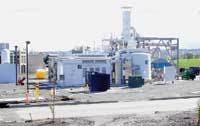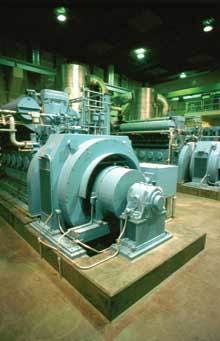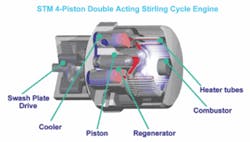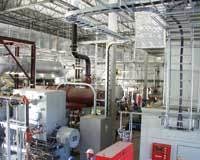The interest in on-site cogeneration systems for wastewater treatment plants has been growing steadily during the last couple of years and is expected to grow further. Some of the factors fueling this interest include the need for standby power (to provide reliability during utility power outages and shortages), availability of free fuel compared to high natural gas prices, interest in green or bio-energy from renewable resources and significant grants and incentives being offered by state and federal governments.
There are a number of energy companies which have shown significant interest in the last couple of years in building cogen facilities for the municipal wastewater market either as design/build or as service contracts.
Biogas or digester gas (DG) produced as a byproduct of the solids stabilization process at WWTPs contains 60 to 70 percent methane, 30 to 40 percent CO2, and other contaminants including H2S, siloxanes, grease, dirt, and water vapor. A varying level of gas treatment is required depending on the need of the cogen technology used.
Grants offered by state and federal governments to encourage green energy from renewable resources make cogen projects more cost-effective, especially in California, where the current state grants are about $1,000/ kilowatt (kW) for reciprocating internal combustion (IC) engines, $1,300/kW for microturbines, and $4,500/kW for fuel cells on renewable fuels like DG and landfill gas (LFG).
The need for standby power also makes the investment on cogen more cost effective. In the economic analysis, it is possible to deduct the cost of a diesel standby generator system from the cost of cogen before evaluating the payback period, net present value or cost per kilowatt hour (kWh).
Internal combustion engines, microturbines, gas turbines, fuel cells, and Stirling engines are the cogen technologies currently being considered for use with digester gas from wastewater treatment plants. The following paragraphs provide the latest on these technologies and some examples of how they are being used.
Internal Combustion Engines
IC engines (reciprocating type) are the most common and proven technology for WWTPs using DG fuel. Lean-burn, spark-ignited, turbocharged and intercooled engines are normally used. They offer low nitrogen oxide (NOX) emissions able to meet emissions regulations of local air districts. Duel-fuel compression ignition engines have also been used with diesel as pilot fuel (instead of spark plugs) for larger size cogen facilities. However, they have somewhat higher emissions. IC engines are normally used for sizes from 250 to 2,500 kW. Manufacturers include Waukesha, Caterpillar, Jenbacher, Fairbanks and Deutz.
Electricity conversion efficiency ranges from 25 to 35 percent. The overall efficiency including lube oil, jacket water and exhaust heat recovery could be 70 to 80 percent. Siloxanes and hydrogen sulfide in DG are significant maintenance issues. Engines with low-pressure fuel systems requiring less than 2 psig pressure are available from some IC engine manufacturers.
Carollo Engineers helped develop an IC engine cogen project at East Bay Municipal Utility District in Oakland, CA, with three 2,150 kW DeLaval Enterprise compression ignition engines using DG with diesel as pilot fuel. The company is currently designing an expansion of this facility from 6.5 megawatts (MW) to 15 MW with consideration for a future increase to about 19.5 MW.
Microturbines
Another cogen technology which has become more common during the last few years is microturbines. Microturbines are miniature industrial gas turbines. Units currently available with DG experience are 30 and 60 kW (by Capstone) and 70 and 250 kW (by Ingersoll Rand). Electricity conversion efficiency is enhanced by use of a recuperation cycle where most of the exhaust gas heat is used to preheat the combustion air charge. There is still plenty of heat which can be recovered as hot water for digester heating.
Microturbines’ electricity conversion efficiency is between 25 to 30 percent. The overall efficiency, including heat recovery, could be as high as 65 to 70 percent. Because of the small clearances and high speed of small rotor blades, fuel gas specifications require near complete removal of all deposit forming siloxanes in the digester gas. Microturbines have very low emissions and permitting is relatively easy. Microturbines require over 50 psig fuel pressure.
Gas Turbines
Industrial gas turbines have a long experience on natural, digester and landfill gas fuels. Gas turbines using digester and landfill gas as fuel are cost-effective for cogen facilities over 3,000 kW size. There are two manufacturers, Solar and Allison, which have DG experience. Gas turbines are required to meet strict air permit regulations. Removal of siloxanes and hydrogen sulfide are maintenance issues.
Electricity conversion efficiency is 30 to 38 percent. The higher efficiency is achieved either with recuperated turbines or by using combined cycle (gas turbine followed by steam turbine). The overall efficiency including heat recovery could be 70 to 80 percent. Gas turbines require over 200 psig fuel pressure. This extra compression energy needs to be considered in the evaluation when comparing alternatives.
An 8 MW Solar gas turbine/steam turbine cogen plant at the King County, Seattle, Renton WWTP is fueled by a combination of digester and natural gas.
Fuel Cells
Like a chemical battery, fuel cells produce electrical energy from gaseous fuel without combustion. Fuel cells are highly efficient and produce negligible emissions. Most air districts do not require a clean-air permit for fuel cells.
Fuel cells are available in 200 to 1000 kW modules from two manufacturers; Fuel Cell Energy (FCE) and United Technologies Corp (UTC). Over 30 units have been operating on natural gas since 1995. Numerous others have been placed in operation on DG in the last couple of years. Because of the availability of high grant money ($4,500 per kW for DG) in California, there has been an extensive interest in fuel cells by a number of energy companies.
Fuel cells’ electricity conversion efficiency is 35 to 50 percent with overall efficiency including heat recovery in the 70 to 80 percent range. Fuel cells require extreme fuel conditioning to remove siloxanes, hydrogen sulfide, and other contaminants in DG. Fuel cells have high capital cost and maintenance costs (for fuel cell stack replacement every 3 to 5 years). When taking into consideration the grant money available in California, fuel cells using DG can be as cost-effective as IC engines and microturbines. Without that grant money, they are not as cost effective.
A 1000 kW fuel cell on DG is operational at the Renton WWTP for King County, Seattle. One of Carollo Engineers’ projects at the City of Tulare, CA, has recently been approved for 750 kW fuel cells on DG.
Stirling Engines
The most recent technology to enter the wastewater treatment plant market is the Stirling Engine. Stirling engine technology has been around a long time, but until recently has not been commercialized in power generation applications. Stirling engines have been used routinely in space craft and military applications as well as small appliance applications. There is currently only one manufacturer of Stirling Engine generator systems, STM Power Inc. They produce a 55 kW unit and have plans for a 75 kW unit ultimately increasing to 250 kW units.
The units are reciprocating engines in which combustion takes place outside of the piston in a manner very similar to a boiler. The combustion products heat up a working fluid inside the piston. As a result, the units can operate on a wide range of low British thermal units (BTU) gaseous fuels, without the need for fuel compression or pre-cleaning being necessary.
Figure 1 shows a schematic view of a Stirling engine. The electrical efficiency of the units is approximately 30 percent and the overall efficiency, including heat recovery, is approximately 80 percent.
Because the combustion process is continuous and occurs at a constant temperature and pressure, it can be controlled for maximum fuel flexibility with very low emissions. NOx and unburned hydrocarbon emissions are lower than for internal combustion engines. No catalytic converter or other exhaust treatment is required. Exhaust emissions are similar to those of boiler systems. Expected maintenance costs are lower than other technologies. Required fuel pressure is less than 1 psig. STM Power has a 55 kW DG-fueled Stirling engine operating at a cogen plant at the City of Corvallis WWTP in Oregon.
About the Author:
Sarwan K. Wason, P.E., a partner with Carollo Engineers, has over 30 years experience in water and wastewater treatment plant design, specializing in energy efficiency and optimization. He holds a MS in mechanical engineering from the University of California, Berkeley and a BS in mechanical engineering from Punjab University, India. He may be contacted via-email at [email protected].






